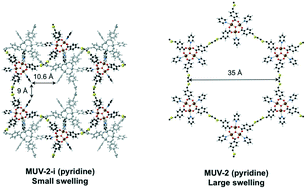Influence of interpenetration on the flexibility of MUV-2†
Abstract
The crystal structure of an interpenetrated tetrathiafulvalene (TTF)-based metal–organic framework (MOF) is reported. This MOF, denoted as MUV-2-i, is the interpenetrated analogue of the hierarchical and flexible MUV-2. Interestingly, the large flexibility exhibited by MUV-2 upon polar solvent adsorption is considerably reduced in the interpenetrated form which can be explained by short S⋯S interactions between adjacent TTF-based ligands ensuring more rigidity in the framework. In addition, the porosity of MUV-2-i is significantly decreased in comparison to that of MUV-2 as shown by the reduced free volume in the crystal structure.



 Please wait while we load your content...
Please wait while we load your content...